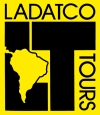Madidi National Park was created in 1995 and covers 1,895,740 ha (4,5000,000 acres; 18,957 km2) from the Amazonian lowlands of the río Heath, at 200 m altitude, to the mountains of the Apolobamba Range at more than 6,000 m altitude. Madidi’s vast wilderness encompasses unparalleled biodiversity ranging from montain cloudforest to dry tropical forest, humid lowland forest to savanna, wild rivers and lakes.
Madidi’s mountains, forests and river habitats are home to more than 1,000 species of neotropical birds, 5,000 - 6,000 superior plants, 44% of all new world species of mammals, and an estimated 38% of neotropical amphibians. The tropical Andes, where Madidi is located, is also a globally critical hotspot of plant endemism. Inside the park’s limits is found the community of San Jose de Uchupiamonas, of the Quechua-Tacana ethnic group.
| General features | |
|
Legal Base: Category: Creation Date: Limits: Extension: |
The
Madidi was created by Supreme Decree Nº
24,123 National Park and Natural Area of Integrated Management (PN ANMI) September 21, 1995. 67º30 '- 69º51' West Longitude, 12º30 '- 14º44 'Latitude South. The area is 1,895,750 hectares (18,957 km2), of which 1,271,500 hectares correspond to the category National Park and 624,250 ha. To the Natural Area of Integrated Management. |
LocationIt is located to the northwest Bolivian, in the provinces Franz Tamayo, Abel Iturralde, Bautista Saavedra and Larecaja of the Department of La Paz. It includes the municipalities of Apolo, San Buenaventura, Ixiamas, Curva, Pelechuco, and Guanay.In Bolivia it borders to the south with the Apolobamba ANMIN and the Biosphere Reserve and TON Pilón Lajas, to the West with the Tambopata Candamo Natural Reserve and the Bahuaja Sonene National Park in the Republic of Peru, forming part of an extensive Bi- National.
PopulationThe pattern of human settlements in the ANIM Madidi PN is very complex, due to its large area and the high diversity of regions it covers. In total, the Area houses some 670 families (about 3,500 inhabitants), distributed in around 33 communities.The most important urban centers in the area of external cushioning of the Area are Apolo to the Southeast (1,628 inhabitants), San Buenaventura (1,670 inhabitants) and Rurrenabaque (4,959 inhabitants) to the East and Ixiamas to the North (1,256 inhabitants).
Relevant aspectsThe PN ANMI Madidi is located in Bolivia's most biologically rich region and its conservation has scope not only in the continental but also in the world, since it is one of the most extraordinary natural reservoirs of genetic resources on the planet.The area is characterized by its exceptional biological richness andthe diversity of ecosystems. Madidi is home to over 4,739 species of higher plants, 1,370 species of vertebrates and 867 species of neo tropical birds.
Madidi is a large center of endemic plants, considered a critical point in conservationPN ANMI Madidi is located in the region of greater biological wealth of Bolivia and its conservation has scope not only in the continental scope but worldwide as it is one of the reservoirs Natural resources of the planet.
It is the protected area with the largest number of bird species in the world and it is thought that with more studies there will be 1,100 or more species.
There are numerous sites of archaeological importance both of Inca origin and Mollo culture, including pre-Columbian roads in the highlands. In addition, the Area is characterized by a great cultural diversity and is the traditional territory of many ethnic groups, both in the lowlands and in the heights.
It is the protected area with the largest number of bird species in the world and it is thought that with more studies there will be 1,100 or more species.
Altitudinal Range
The altitudinal range of the Area is very wide and ranges from 6,000 to 200 meters above sea level, from the high mountain ranges in the area of Apolobamba to the Amazon plain of the Heath River.
Biogeographically, the Area corresponds to the subregions of Puna, Yungas Mountainous Forest and Moist Wood Forest.
HydrographyThe Hydrography of the Area is defined by the Tuíchi, Quendeque, Hondo Madidi river basins that flow into the Beni River and the Heath that flows into the Madre de Dios River, two important watersheds of the Amazon.Flora del Madidi
Due to the wide altitudinal range, the area presents an extraordinary diversity of eco regions: snowy areas and peri glacial environments, Yungueño Paramo, Cloudy Eyebrow Forest, Yungas Perhumid Rainforest, Subandean Rain Forest, San Juan del Asariamas Dry Forest (One of the last well-preserved specimens in Bolivia), Basal Seasonal Humid Forest, Flood Sheets, and Royal Palm Groves (Mauritia flexuosa and Mauritiella aculeata).There are estimated from 5,000 to 6,000 species of higher plants in the entirearea.
These include species like the Queñua (Polylepis racemosa triacontranda), including a new species for science, huaycha (Weinmannia microphylla), iotavio (Weinmannia boliviensis and W. crassifolia), walnut (Juglans boliviana), yuraj huaycha (Miconia theaezans ), Wild pines (Eugenia sp.), Alder (Alnus acuminata), chachacoma (Escallonia myrtilloides), yarumas (Hesperomeles ferruginea and H. lanuginosa), red alder (Podocarpus spp. Myrica pubescens), myrtle (Randia boliviana), limachu (Myrsine coriacea), sauco (Sambucus peruviana), laurels (Ocotea spp. And Nectandra spp.), Redadillo (Byrsonima indorum), cinchona Officinalis), isigo (Tetragastris altissima), bilka (Anadenanthera colubrina), bibosi (Ficus spp.), Guitarist (Didymopanax morototoni) and bizcochelo (Miconia multiflora).
There are also numerous timber species such as mara (Swietenia macrophylla), cedar (Cedrela odorata), palo maría (Calophyllum brasiliense) and ochoó (Hura crepitans).
In addition, the area presents a great diversity of palms, among which we can mention: Ceroxylon pityrophyllum (as very rare), jatatas (Geonoma megalospatha, G. lindeniana and G. deversa), pachiuva (Socratea exorrhiza) (Iriartea deltoidea), Motacú (Scheelea princeps), several Chontas (Astrocaryum spp.), Ivory palm (Phytelephas macrocarpa), icho (Dictyocaryum lamarckianum), palm asaí (Euterpe precatoria) and royal palm (Mauritia flexuosa).
Madidi wildlife
There are 733 species of fauna registered for the Area, especially mammals, birds, reptiles and fish.Among the mammals, jucumari or spectacled bear (Tremarctos ornatus), Andean cat or titi (Felis jacobita), the Andean deer (Hippocamelus antisensis), white-tailed deer (Odocoileus virginianus), the puma (Felis concolor), the jaguar (Panthera onca), having been reported melanic varieties, tiger (Felis pardalis), tropero (Tayassu pecari albirostris), marsh deer (Odocoileus dichotomus), londra (Pteronura brasiliensis), Marimono (Ateles paniscus), manechi (Alouatta seniculus) and several species of the family Callitrichidae.
620 species of birds have been recorded , although it is estimated that there are 1,100 species in the Park.
About 90 % of the birds found in Bolivia. The park is home to species such as the crested eagle (Oroaetus isidori), the cock of the rock (Rupicola peruviana), the harpy eagle (Harpia harpyja) , the endemic humming bird (Oreotrochilus adela and Aglaeactis pamela), as well as species in danger of extinction such as erythrotis grallaria that is endemic to the region , and others.



